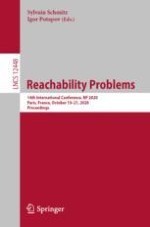2020 | OriginalPaper | Chapter
The Collatz Process Embeds a Base Conversion Algorithm
Authors : Tristan Stérin, Damien Woods
Published in: Reachability Problems
Publisher: Springer International Publishing
Activate our intelligent search to find suitable subject content or patents.
Select sections of text to find matching patents with Artificial Intelligence. powered by
Select sections of text to find additional relevant content using AI-assisted search. powered by
